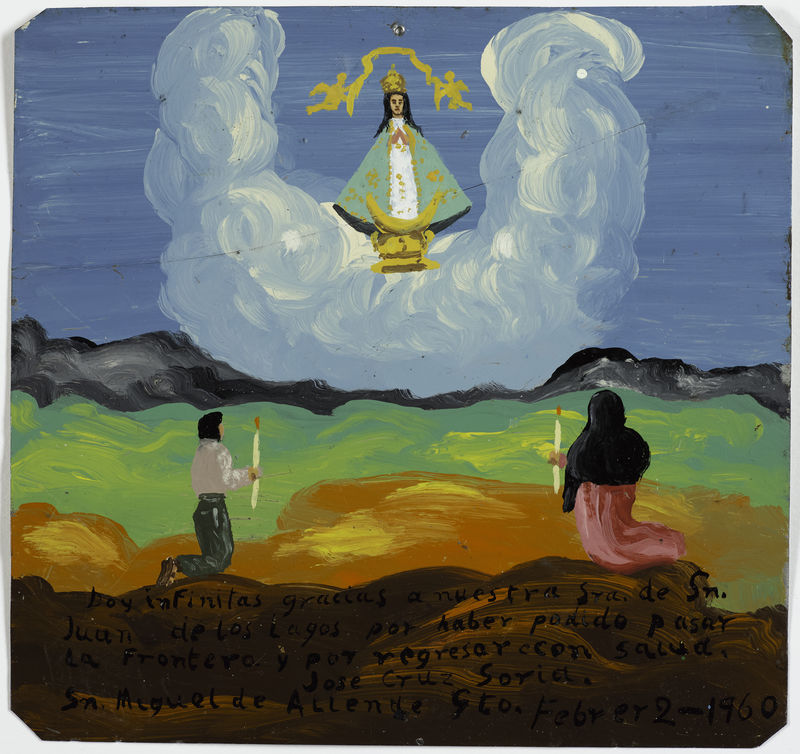Retablos are thank-you notes to the heavens dedicated to Christ, the Virgin, or saints to consecrate a miraculous event. The votives on view—spanning the entirety of the twentieth century—were offered by Mexican migrants and their families to commemorate the dangers of crossing the border and living in the United States. Filled with emotive detail, they eloquently express subjects of greatest concern to the migrants, such as the difficulty of finding work or falling sick in a foreign land and the relief of returning home.
The word “retablo,” from the Latin retro tabulum (behind the altar table), originally referred to devotional paintings hung in Catholic churches in Europe. In Mexico, reflecting traditions embedded in local cultures by Spanish conquest beginning in the sixteenth century, retablo (synonymous in this usage with ex-voto, lámina, and milagro) came to denote a small oil painting on metal placed on the wall of a shrine or church.
Usually commissioned from local artists working anonymously, retablos feature a narrative that is both written and pictorial. First-person vignettes, dated and inscribed with the supplicants’ names, draw on a traditional vocabulary such as “doy infinitas gracias” (I give infinite thanks). In the luminous illustrations above the inscriptions, earthly figures share space with holy images and a dreamlike representation of the miracle. As they accumulate on church walls, both in Mexico and the United States, these votives become public records of private faith, fears, and familial attachments.
Download the exhibition checklist
Retablos son notas de agradecimiento a los cielos dedicadas a Cristo, a la Virgen, o a los santos para consagrar un evento maravilloso. Los exvotos expuestos aquí—que abarcan todo el siglo XX—fueron ofrecidos por migrantes mexicanos y sus familias para conmemorar los peligros de cruzar la frontera y vivir en los Estados Unidos. Llenos de detalles emotivos, expresan de manera elocuente los temas de mayor preocupación para los migrantes, tales como la dificultad de encontrar trabajo o enfermarse en tierra extranjera y el alivio de regresar a casa.
La palabra “retablo,” del latín retro tabulum (detrás de la mesa de altar), se refería originalmente a pinturas devocionales colocadas en las paredes de las iglesias católicas en Europa. En México, debido a las tradiciones incorporadas a las culturas locales con la conquista española a partir del siglo XVI, retablo (sinónimo de exvoto, lámina y milagro) vino a significar una pintura pequeña al óleo sobre metal, colocada en la pared de un santuario o de una iglesia.
Generalmente encargados a artistas locales que trabajan de forma anónima, los retablos presentan una narrativa tanto escrita como gráfica. Las viñetas en primera persona, fechadas e inscritas con los nombres de los suplicantes, recurren a un vocabulario tradicional como “doy infinitas gracias.” En las ilustraciones luminosas sobre las inscripciones, las figuras terrenales comparten el espacio con imágenes sagradas y una representación onírica del milagro. A medida que se acumulan en las paredes de las iglesias, tanto en México como en los Estados Unidos, estos exvotos se convierten en registros públicos de la fe, los miedos y los vínculos familiares privados.
Haga clic aquí para descargar la lista de obras en la exposición
